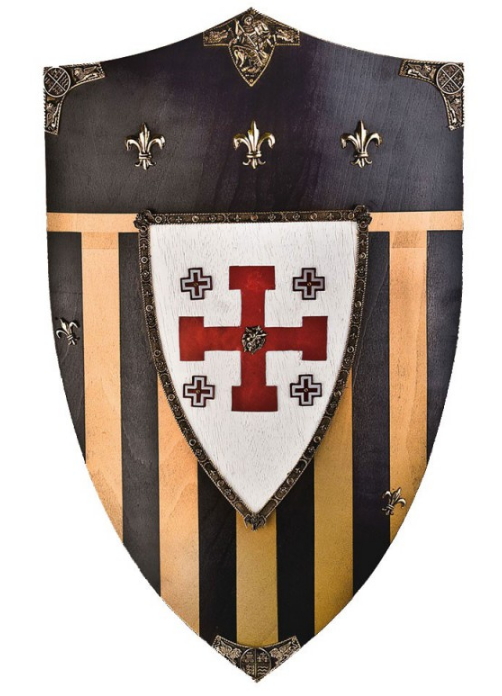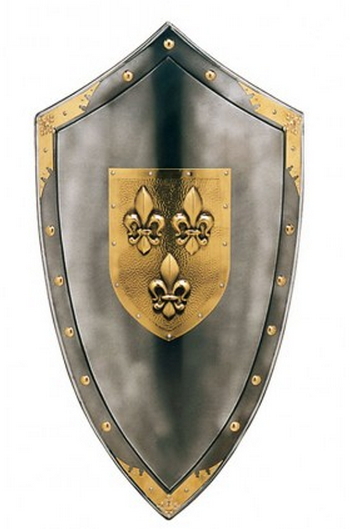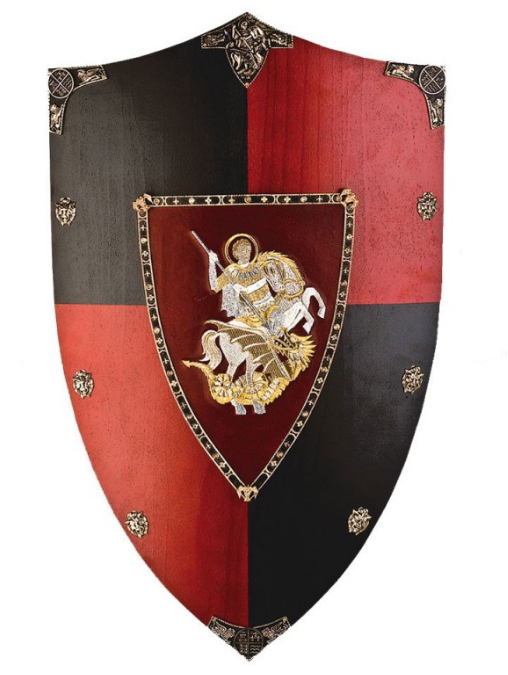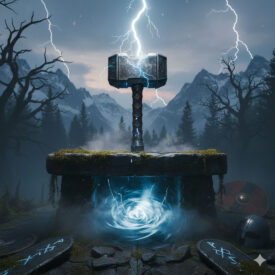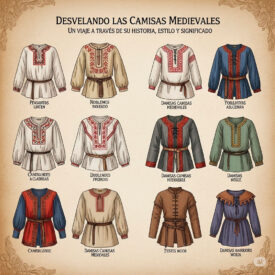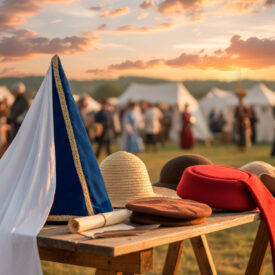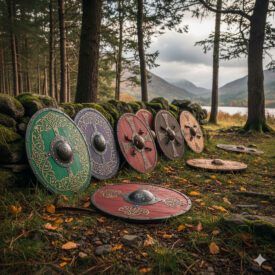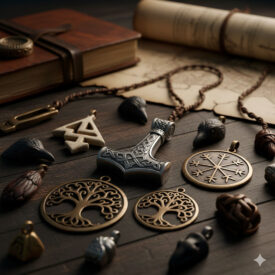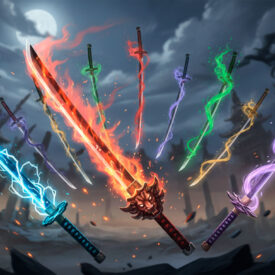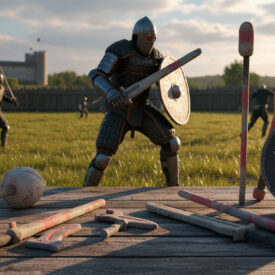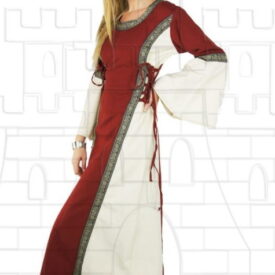The medieval shields were not merely objects to deflect blows; they represented the soul of a warrior and the identity of his people. From their rudimentary origins to the complex designs of the Middle Ages, shields evolved alongside combat strategies and weapon technology, becoming powerful symbols of status, loyalty, and power. They were the first line of defense, an extension of the fighter himself, and their design and use reflected the tactical sophistication of the era. The history of warfare throughout time is intrinsically linked to the evolution of these defensive pieces, which went from being simple planks to functional and emblematic works of art.
A Journey Through Time: The Evolution of the Shield
The need for protection in combat led to the creation of the shield more than 3,000 years before Christ. In the beginning, they were simple objects made of materials like wood or wicker, designed to deflect the most basic attacks. However, their evolution was constant and fascinating, adapting to technological advances and the changing military tactics of each era. With the arrival of heavy cavalry and new weapons like the crossbow, shields became more specific and specialized, giving rise to a rich diversity of shapes and purposes.
The earliest shields were often large and heavy, designed to cover a significant portion of the body. As combat techniques were refined and armor offered more protection, shields could become lighter and more maneuverable, allowing greater agility on the battlefield. Experimentation with different materials and construction methods was key in this evolution, always seeking the perfect balance between strength, weight, and functionality. The Byzantines, for example, mainly used oval-shaped shields, while the Normans innovated with an almond shape that offered specific advantages in mounted combat.
Emblematic Types of Medieval Shields
The Middle Ages saw the emergence of an impressive variety of shields, each designed for specific tactical needs and adapted to different styles of combat. The shape, size, and materials of a shield often indicated its purpose and the type of warrior who carried it. Below, we explore some of the most emblematic types and their role in medieval warfare.
Round Shields
Common at the beginning of the Middle Ages, round shields were largely popularized by the Vikings. They were mainly made of wood and often reinforced with a central iron boss. This boss not only protected the wielder’s hand but could also be used offensively to strike or unbalance the opponent. They were extremely versatile in hand-to-hand combat and proved particularly effective in defensive formations such as the “shield wall,” where warriors lined up, overlapping their shields to create an almost impenetrable barrier.
Norman or Kite Shields
Emerging in the 11th century, Norman shields, also known as kite shields, featured a characteristic almond or teardrop shape. This innovative silhouette offered superior protection extending from head to knee, making them ideal for mounted warriors, especially knights. Their design allowed the rider to protect much of his body without hindering the movement of his horse or the use of his lance. They played a crucial role in historical events such as the Norman Conquest of England, where heavy cavalry, protected by these shields, was decisive.
Heraldic or Triangular Shields
In the High Middle Ages, from the late 13th century to the 16th century, shields became smaller and adopted an equilateral triangular shape, often with a more rounded apex. This evolution offered a good balance between protection and mobility, being especially suitable for mounted knights who needed greater agility. These shields quickly became the perfect canvas for coats of arms and heraldic symbols, giving rise to a complex system of visual identification on the battlefield and in feudal society. Heraldry developed largely due to the visibility and space these shields offered for displaying family and lineage emblems.
Pavises
Pavises were large rectangular shields, often human-height, mainly used in the Late Middle Ages and early Renaissance. Their size provided comprehensive protection to archers and crossbowmen, allowing them to reload their weapons safely while sheltered. They could be staked into the ground to form mobile defensive walls during sieges or to protect static formations. Their use was fundamental for missile troops, who needed considerable cover to operate effectively under enemy fire. The concept of the pavise is similar to the Roman Scutum, an oblong shield used by legionaries for the testudo formation, although the medieval pavise was more specialized for ranged combat.
Bucklers
Bucklers were small fist shields, generally between 15 and 45 centimeters in diameter, very popular in the Late Middle Ages. Light and extremely maneuverable, they were excellent for hand-to-hand combat and were often used in combination with swords. Their size allowed for both defense and simultaneous attack, making them ideal for deflecting blows, blocking, and sometimes even striking or unbalancing the opponent. Their agility made them indispensable in duels and skirmishes where speed and precision were key.
Other Notable Types of Shields
In addition to the main types, the rich history of shields includes a variety of designs adapted to different cultures and eras. We can basically mention:
- Adarga: An oval shield, typically of Hispanic-Moorish origin, constructed with two leathers sewn together. Its light and resistant design made it popular among light cavalry.
- Aspis: The characteristic shield of Greek infantry, especially hoplites. It was a large, circular shield with a concave design that covered much of the body.
- Clipeus: Similar to the Aspis, it was a large, circular shield used by both Greeks and Romans, mainly by heavy infantry.
- Rodela: A medium-sized round metal shield, used in the Middle Ages, especially in hand-to-hand combat and duels.
- Targe: A round shield, typically Scottish, often covered in leather and adorned with metal studs, used in combination with the sword.
- Tarja: A medieval shield that, due to its size, covered almost the entire body of the bearer, similar in function to a pavise, but often with a more curved or angular shape.
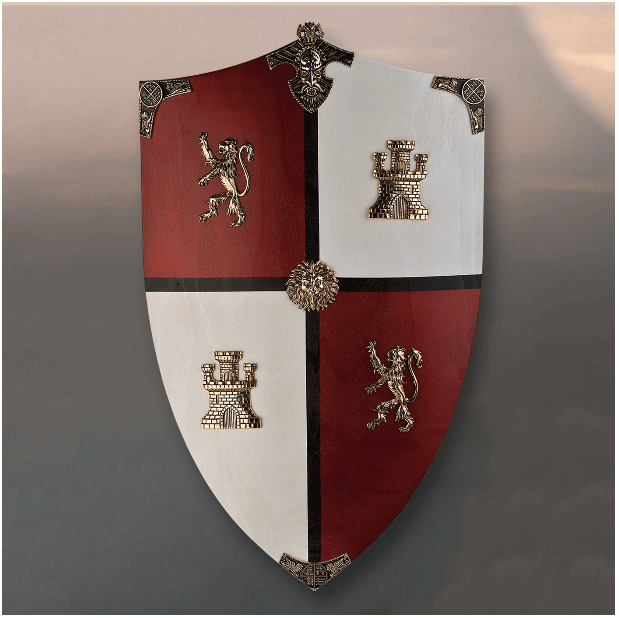
The Art of Construction: Materials and Techniques
The making of a medieval shield was a complex artisanal process that required the skill and coordination of various trades. Wood was the fundamental material for most medieval shields, with options such as oak, ash, or linden, carefully chosen for their specific properties: lightness, strength, or flexibility. The boards were joined, often in several layers and in opposite directions, to increase stability and the ability to absorb impacts without breaking. This lamination was crucial for the shield’s durability in the heat of battle.
For greater durability and protection, shields were reinforced with other materials, transforming them into pieces of defensive engineering:
- Leather or Linen: Stretched and glued over the wooden surface, adding a layer of resistance against moisture, wear, and cuts. In some cases, the leather could be hardened by boiling or special drying processes, achieving a consistency almost as hard as metal, which significantly increased protection against cutting blows.
- Metal: Metal bands, generally of iron or steel, reinforced the edges of the shield, protecting them from splintering and damage caused by direct impacts. A distinctive element was the metal boss, a dome or metal cone placed in the center of the shield, which protected the wielder’s hand from direct blows. Bosses not only offered vital protection but could also be used offensively to strike the opponent, unbalance him, or even deflect his weapon. Towards the end of the Middle Ages, with advances in metallurgy, fully metal shields appeared, although they were considerably heavier and less common than their reinforced wooden counterparts.
The manufacture of a shield was, therefore, a testament to the artisanal mastery of the era, combining the skills of carpenters for the wooden structure, tanners for the leather treatment, and blacksmiths for the metal reinforcements. Each shield was a unique piece, adapted to the needs and preferences of its bearer, and represented a considerable investment in time and resources.
Shields in Battle: Tactics and Strategies
The shield was not just a physical barrier against blows and projectiles, but a key piece in medieval combat tactics and strategies. Its effective use could determine the outcome of a skirmish or a large-scale battle.
The Shield Wall
One of the most formidable defensive tactics of the Middle Ages was the “shield wall.” In this formation, warriors lined up shoulder to shoulder, overlapping their shields to create an almost impenetrable barrier. This tactic was incredibly effective against cavalry attacks, which were slowed by the solid mass of shields, and against projectiles such as arrows or javelins, which bounced off the surface of the formation. The shield wall allowed infantry to withstand superior charges and hold their position, serving as a solid base from which to launch counterattacks.
Cavalry Attacks and Mobility
For cavalry, the choice of shield was crucial to maintain mobility and offensive effectiveness. Smaller and lighter shields, such as triangular or kite shields, offered protection to knights while allowing them to maneuver their horses and use their lances or swords freely. The almond shape of Norman shields, for example, was perfectly designed to protect the rider without interfering with the horse’s movement. Some shields, especially those of infantry, could be staked into the ground to form an improvised protective wall, offering temporary shelter to regroup or to protect archers.
Sieges and Individual Combat
In sieges, pavises played a vital role, protecting ranged fighters (archers and crossbowmen) while they reloaded their weapons. These large shields could form defensive lines for assault troops or protect defenders on the walls. In duels or individual combats, small shields like the buckler were fundamental. Their lightness and maneuverability allowed agile defense and could also be used offensively to unbalance the opponent, create openings, or even strike with the edge or boss, demonstrating that the shield was both a defensive tool and an offensive extension of the warrior.
Deep Symbolism: Heraldry and Painting
Beyond their practical function as combat tools, shields were powerful vehicles of symbolism, playing a crucial role in the identity, status, and visual communication of medieval society.
Identity and Status
Decorated with vibrant colors and complex emblems, shields identified warriors in the chaos of battle. These designs not only allowed friends to be distinguished from foes, but also reflected the beliefs, loyalties, social status, and aspirations of their bearer. A luxuriously decorated shield, with precious metals or intricate designs, was an unequivocal symbol of wealth, power, and high rank within the feudal hierarchy. The display of a shield was a public declaration of who the warrior was and to which house or lineage he belonged.
The Origin of Heraldry
The pressing need for identification on the battlefield, especially as armor increasingly covered the faces of knights, led to the development of heraldry. This complex system of symbols and colors, with strict rules for their design and transmission, became a science and art in itself. The triangular shield, with its flat and well-defined surface, was crucial in the development of heraldry, serving as the ideal “canvas” for coats of arms passed down from generation to generation, establishing lineages and family alliances.
Heraldic Colors and Symbols
Each element in a heraldic coat of arms had a specific meaning. The colors, or “tinctures,” such as red (gules, symbolizing valor and courage), blue (azure, representing loyalty and truth), green (vert, associated with hope and joy), or black (sable, denoting constancy and wisdom), conveyed clear messages without words. The symbols, or “charges,” were equally significant: the lion (courage, strength, nobility), the eagle (authority, imperial power), the cross (Christian faith, participation in crusades), or the fleur-de-lis (purity, French royalty) told stories of lineage, military feats, alliances, and family values. The combination of these elements created a rich and complex visual language.
Shield Painting
The painting of shields not only embellished these defensive pieces but was also fundamental to their identification function. Artists specializing in heraldry used natural pigments and advanced techniques, such as tempera (a technique that used egg yolk as a binder), to create vivid and durable colors that could withstand the elements and the rigors of combat. The work required great skill, not only for artistic precision but also for the need to apply designs to curved surfaces and ensure durability that would withstand use in battle. These artists were true masters, merging art with martial functionality.
A Lasting Legacy
Although the military use of classic shields drastically decreased with the improvement of plate armor and, above all, with the appearance and perfection of firearms, their legacy and symbolism remain alive and relevant today, permeating various facets of our culture.
Modern Protection
The fundamental concept of the shield, the protection of vital areas of the body against external threats, endures in modern defensive technologies. Bulletproof vests, ballistic shields used by police units and special forces, and vehicle armor follow the same basic principle: to interpose a resistant barrier between the user and danger. The evolution of materials and techniques has made it possible to create lighter and more effective protections, but the essence of passive defense through a shield remains unchanged.
Reenactment and Popular Culture
Medieval shields enjoy immense popularity in historical reenactment and live-action role-playing (LARP). Enthusiasts around the world strive for authenticity in the making and use of shield replicas, participating in events where battles and medieval life are simulated. In addition, the iconic image of the medieval shield is omnipresent in popular culture: movies, television series, video games, and fantasy and medieval-themed literature constantly feature them, keeping the fascination for this era and its distinctive elements alive. They are a recognizable symbol of bravery, chivalry, and adventure.
Living Heraldry
Heraldry, born and developed largely thanks to shields, remains a living and relevant discipline today. Medieval coats of arms and symbols, with their intricate rules and meanings, adorn official documents, city and country shields, logos of educational institutions, sports clubs, and even modern corporate identities. This continuity demonstrates how a visual communication system devised centuries ago for the battlefield has transcended its original purpose to link the past with the present, symbolizing tradition, history, and belonging.
Medieval shields are much more than simple war artifacts. They are eloquent witnesses to the evolution of societies, human ingenuity in defense and attack, and a rich system of visual communication that, through their shapes, materials, and symbols, continues to tell us fascinating stories of protection, identity, status, and the complexity of the Middle Ages. Their legacy endures, not only in museums and history books, but also in popular culture and modern design, reminding us of the profound importance they had in shaping the warfare and society of their time.
If you are passionate about medieval history and want to explore the beauty and functionality of these historical pieces, we invite you to discover a wide selection of high-quality replicas and miniatures. You can SEE MEDIEVAL SHIELDS authentic, explore SHIELDS FROM ALL ERAS, or collect SHIELD MINIATURES that capture the essence of these magnificent pieces of history.

